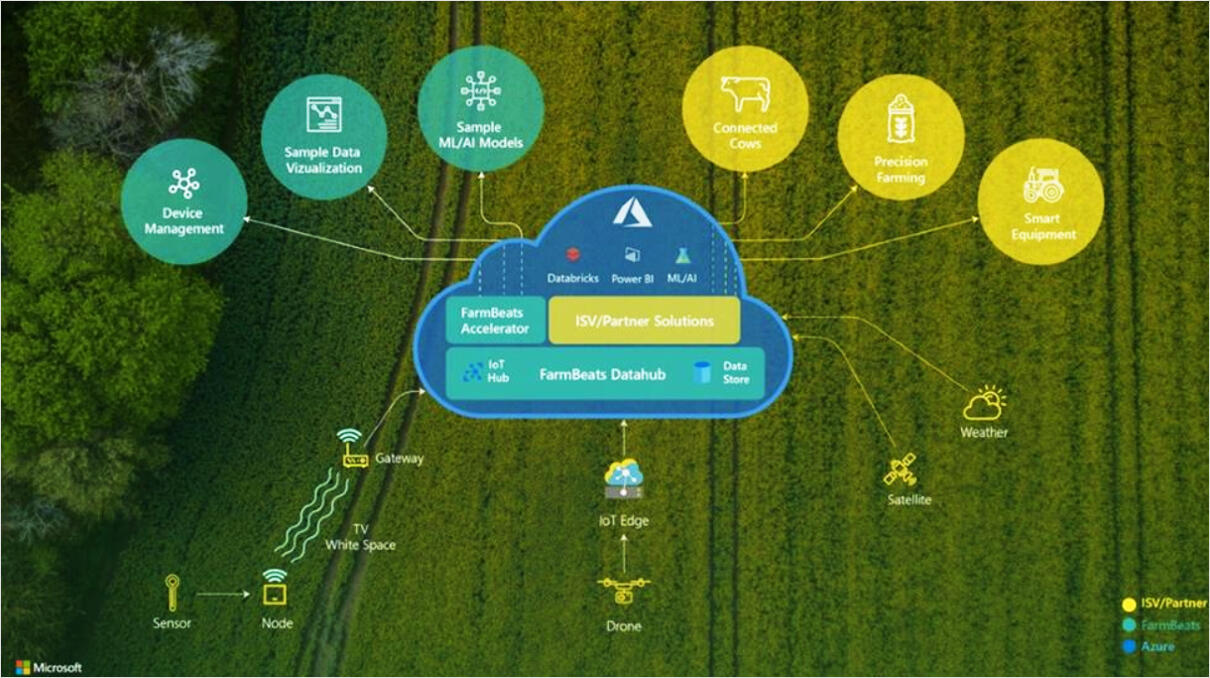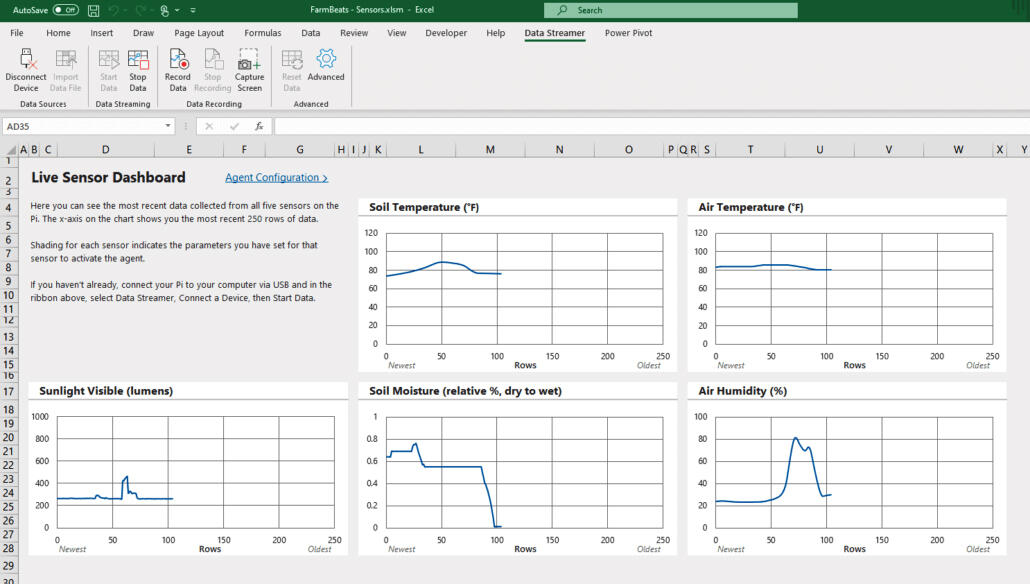
Microsoft’s Azure IoT platform helps make farming greener as well as smarter
Precision agriculture brings sensors, AI, and farming together to deliver better crops with lower environmental impact. Now it’s also helping to track carbon.

Image: Microsoft
We often think of the Internet of Things (IoT) as applicable to the home or industry, but it has a far wider reach. There’s an old adage that says “you can’t change something if you can’t measure it”, which encapsulates much of how we build control systems. But what happens when those measurements are more precise and more detailed than we’ve previously been able to make? Suddenly, much more targeted changes are possible, because we now have a much higher level of knowledge about what’s happening — and more importantly, why.
One area that’s seeing significant (and often unexpected) benefits from IoT is agriculture. Simple devices can provide detailed information that we’ve not had before, like continuous measures of soil moisture, or tracking lighting conditions and temperature to calculate when best to harvest a crop, all at vary affordable costs.
SEE: Juggling remote work with kids’ education is a mammoth task. Here’s how employers can help (free PDF) (TechRepublic)
Remote sensing for agriculture used to be expensive. It needed aircraft, multi-spectrum cameras, and expensive software to process the images and extract data. And even then, all you knew was what conditions where at a specific time on a specific day. Now low-cost consumer drones, low-power wireless networks, microcontrollers and sensors mean it’s possible to get access to continuous data affordably. What’s needed, however, is a common layer to bring in the data from all those sensors and turn it into actionable information, enabling what’s now known as ‘precision agriculture’ or ‘smart farming’.
With precision agriculture you’ll know when to water, when to fertilise, when to harvest, when to treat plants for disease. It takes the guesswork out of farming, using machine learning to interpret data and to advise farmers on what to do and when to do it. That should result in less water wastage, more efficient use of chemicals, and hopefully higher yields for lower environmental impact.
Using Azure FarmBeats for precision agriculture
That’s where Microsoft’s Azure FarmBeats project comes into play. The commercial release of a Microsoft Research project, it’s a set of software layers that work with remote sensing devices to extract and process data and then use machine-learning models to predict how a farm should respond to those results.
Currently in preview, FarmBeats is built around the concept of a Datahub API layer. This provides APIs for sensors and imagery, with support for three different sensor manufacturers and a mix of drone and satellite imagery. This data is then processed and normalised, so it can be treated as a common data source for all your agricultural sensing. The platform is extensible, and you can use REST APIs to add your own sensors to the system, using its published OpenAPI descriptions to write sensor code, authenticating via Azure Active Directory.
Once data has been captured and processed you can create a mix of different reports, as well as using it as a data source for other applications and tools. FarmBeats maps everything to a specific area, a logical farm, and can help advise you on the placement of sensors and appropriate intervals for aerial imagery.
FarmBeats for Students: learn precision agriculture techniques on a Raspberry Pi
The full FarmBeats system is designed for larger farms, but Azure’s consumption pricing model should make it economical for all sizes of agricultural business. A related program, FarmBeats for Students builds on familiar single-board computers and simple sensors to build and deploy a basic precision agriculture sensing suite on a Raspberry Pi and using Microsoft Excel to capture and analyse data. It’s a good introduction to the concepts and can be used to learn how to get started with real-time sensors and machine learning. A free curriculum helps you get started and shows you how to build and deploy a simple sensor network.

Live data from five sensors connected to a Raspberry Pi 4, displayed in Excel.
Image: Microsoft FarmBeats for Students
Once you’re familiar with the concepts, and more importantly, how to interpret and use the results, you can start to move to the Azure FarmBeats platform, where you’ll get access to a wider array of sensors and source data.
Tracking carbon with precision agriculture techniques
One aspect of precision agriculture is that it finally provides a way of showing that farms are meeting their carbon credit commitments. Selling carbon credits to companies like Microsoft, which has committed to being carbon negative by 2030, can be profitable for small farms, but there’s the risk of fraud upsetting the careful calculations. It’s tempting for both sides of the transaction to overstate the amount of carbon being sequestered, so what’s needed is a better way of tracking progress than paper records.
That’s where you can start using precision agriculture tools like Azure FarmBeats, as they can monitor what’s growing, and more importantly, how well it’s growing. That information can be used to calculate how much carbon is being sequestered by what plants, or how it’s being trapped in soil, which gives both farmer and credit-buyers a firm ledger entry for the carbon credits being exchanged. Companies can then be clear that they are meeting commitments as part of their annual reports, with verified data that can be audited alongside the rest of their accounts.
You can see something of this in Microsoft’s work with dairy giant Land O’Lakes, which is building FarmBeats into its Truterra soil health platform. This will allow farms to understand the content of their soil and help use it as a carbon sink that can generate carbon credits. Using soil to absorb carbon improves soil quality, making it easier to grow plants without large amounts of chemical fertilizers.
Microsoft has also been working directly with US rice farmers to change how they grow rice, introducing methods that prevent the production of methane in flooded fields. Sensors can help ensure that the correct level of moisture is present, and that no methane is present. By giving farmers a feedback loop, they can apply appropriate controls quickly, avoiding overshoots and keeping field conditions within necessary limits.
FarmBeats’ network of sensors takes the guesswork out of farming, ensuring that farmers have the data they need to make the right decisions for their crops and for their land. With versions of the platform suitable for all sizes of farm, from smallholdings all the way to the largest industrial concerns, it’s a surprisingly easy service to deploy. Extending it to managing carbon credits is a logical move, and one that should help Microsoft and other companies get closer to their negative carbon footprint commitments.
Also see
Stay connected with us on social media platform for instant update click here to join our Twitter, & Facebook
We are now on Telegram. Click here to join our channel (@TechiUpdate) and stay updated with the latest Technology headlines.
For all the latest Technology News Click Here
For the latest news and updates, follow us on Google News.


